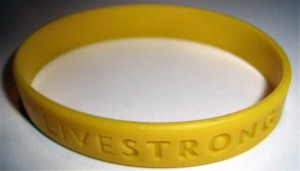Let’s All Band Together
April 23, 2013

Everyone has seen them, whether at the gym, in class, or just hanging out. Wristbands that serve some sort of purpose other than fashion, these bands claim to help people live better, or at the very least provide the wearer a compass to enhance their wellbeing. The question stands, should people band together or keep their wrists clear of digital clutter?
The silicon bracelet craze started in 2004 with NIKE and Lance Armstrong creating the Livestrong bracelet, which was quickly established as the must have piece of sports equipment. This little piece of yellow silicon became a lightning bolt for those who wore it. It carried with it the message “live strong” and take on anything. Soon after, sports officials from several different fields started banning players from wearing them after stating safety concerns i.e. if another player were to get caught in another’s wristband, it could cause an unfortunate chain reaction resulting in injury.
In 2006, PowerBalance came on the scene with a wristband that used a special hologram based on eastern philosophies, to enhance the energy and balance of the wearer. Golfers seemed to be drawn to this idea and many became sponsors, like Stacy Lewis and Keegan Bradley. However, the company that touted such amazing results had their power balance thrown off in 2011 when it was reported by gizmodo.com, among others, that the wondrous wristband didn’t wield any worthwhile benefits. A quote from the PowerBalance Company stated, “We admit that there is no credible scientific evidence that supports our claims and therefore we engaged in misleading conduct.” The company, although still in business, was found guilty of breach s52 of the Trade Practices Act of 1974.
But this in no way means that every wagon rolling into town is trying to sell consumers the wonder cure for their lives that snaps on their wrist is a sham. Three groups had their ears to the ground and heard the buffalo coming. Nike decided to grab at the wrists of consumers with their FUEL band, which tracks the amount of movement by the wearer, whether playing basketball, swimming, or simply going for a walk, as well as other activities. The goal is essentially to keep moving to fill the users “fuel” meter up and sync it with a profile to see where their friends stack up. It is basically a pedometer for your wrist, but with the aesthetics and social network it is getting people to move more, and who would argue with those results?
Jawbone has been making jaws drop with their big thing in a small package design.
The company’s UP band, when paired with the free smart phone app, has the equivalence of a Swiss army knife on steroids. On its own, the band can seamlessly track the users sleep patterns, movement, and food intake. The app also allows the user to join other users’ teams to achieve goals throughout the day, motivate others, or share meal/workout info. This becomes extremely beneficial when it comes to staying on track. Another aspect of this fitness tool is that it is sweat-proof and waterproof, which makes recreational water activities an easy transition. While monitoring sleep, the UP band can analyze the grade of sleep the user is getting, and send a light vibration to assist in waking the individual up at the optimal time for maximum comfort and transition from being asleep to being awake.
Jawbone isn’t the only heavy hitter in the techno-infused wristband game. Fitbit is the up-and-comer which brags basically the same features with two additions. The first being the ability to change band colors, which if the wearer is fashion conscious will be a big plus, and the second, and probably the most convenient feature, is the ability to sync via Bluetooth. On the down side, its battery life is only five to seven days. The Fitbit bracelet is set to launch this spring.
So the question still stands: are the benefits of a 24-hour wristband actually beneficial? With its ability to track movement, sleep patterns, and register nutritional info in this difficult-to-stay-healthy, fast-food-everywhere culture, the benefits are becoming clearer and clearer. When all of the considerations have been made, it can be stated that, although wristband technology is just starting to show real progress, (wrist)banding together might not be a bad idea after all.







